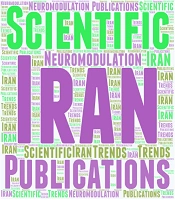Dear Editor,
In the 21st century, neuroscience is facing a major challenge due to the rapidly increasing aging population and the consequent rise in the prevalence of dementia, brain aging, and aging-related cognitive impairments (1). The average age in Iran has increased by 2.9 years compared to the last five years. Also, the population over 60 years old in Iran has increased from 14.1 to 17.2% compared to the last five years, which is predicted to reach 25.3% in 2030 (2). Neuromodulation is a promising way for research in the field of aging (1). Therefore, due to the increase in the elderly population in Iran, it is necessary to pay further attention to studies and research in the field of neuromodulation.
We searched the Scopus database to review the number of studies in the field of neuromodulation; the used keywords in this search consist of "Electroanalgesia" OR "Neuromodulation" OR "Transdermal Electrostimulation" OR "Percutaneous Neuromodulation Therapy" OR "Analgesic Cutaneous Electrostimulation" with Iran affiliation. We did not consider any time limitation. This search was conducted on January 11, 2021, and the total number of studies in the field of neuromodulation and the number of studies in rank Q1 in Iran is shown in Figure 1. Overall, 285 studies were retrieved by searching Scopus database, and after reviewing the studies, it was found that Tehran University of Medical Sciences, Shahid Beheshti University of Medical Sciences, and the Institute for Studies in Theoretical Physics and Mathematics had the uppermost research activities in the field of neuromodulation.
The number of research studies and their scientific level in the field of neuromodulation in Iran is increasing, indicating that the significance of research in the field of neuromodulation for Iranian researchers has become clear. However, due to the rapid growth of the elderly population in Iran (2), it is necessary that relevant institutions further support research projects in the field of neuromodulation to use neuromodulation science in the near future. In doing so, the therapeutic, economic, and social burden resulting from a further increase in the elderly population will be reduced.

.png)
